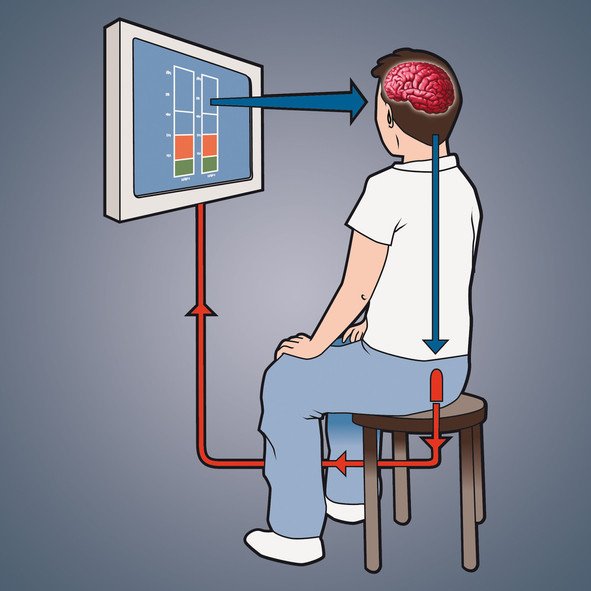Biofeedback
Medically reviewed by Drugs.com. Last updated on Jun 24, 2023.
What is Biofeedback?

Biofeedback tries to teach you to control automatic body functions such as heart rate, muscle tension, breathing, perspiration, skin temperature, blood pressure, and even brain waves. By learning to control these functions, you may be able to improve your medical condition, relieve chronic pain, reduce stress, or improve your physical or mental performance (sometimes called peak performance training).
During biofeedback training, sensors attached to your body detect changes in your pulse, skin temperature, muscle tone, brain-wave pattern, or some other physiological function. These changes trigger a signal —a sound, a flashing light, or a change in pattern on a video screen — that tells you that the physiological change has occurred. Gradually, with the help of your biofeedback therapist, you can learn to alter the signal by taking conscious control of your body's automatic body functions.
What it's used for
Although biofeedback has been used to treat a variety of health problems, there is mixed scientific evidence that it works for most of them. There are exceptions, however. Multiple studies show that biofeedback may reduce migraine and tension-type headache. It can also be effective for certain types of urinary incontinence, fecal incontinence, and anal pain related to excessive muscle contractions and constipation caused by problems with the muscles in the anus.
|
Biofeedback to help with incontinence |
Biofeedback has been used to help reduce symptoms in some people with
- chronic pain
- migraine
- fibromyalgia
- temporomandibular joint (TMJ) disorders
- digestive disorders, including constipation
- incontinence (both urinary and fecal)
- high blood pressure (hypertension)
- abnormal heart rhythms (cardiac arrhythmias)
- addiction, including to alcohol
- epilepsy
- paralysis and certain movement disorders
- spinal cord injury
- sleep disorders
- premenstrual syndrome (PMS)
- bedwetting (enuresis)
- attention deficit disorder (ADD) and attention deficit hyperactivity disorder (ADHD)
- panic disorder
- anxiety disorder.
Preparation
For people who try biofeedback, some preparation is helpful. This preparation can involve
- reading about biofeedback, so that you have a general concept of the process before you start
- being motivated to spend the time and effort required to complete your course of biofeedback.
If your doctor refers you to a therapist for biofeedback, the therapist will contact the doctor to obtain relevant information regarding your current health problems before you begin therapy.
If your doctor has not referred you to a biofeedback therapist, but you want to try biofeedback, call your doctor first to discuss the situation. This will give you an opportunity to hear your doctor's thoughts about biofeedback as a treatment for your specific health problem. It also will help to give your doctor a more complete picture of the treatments you are using.
Before you begin biofeedback therapy or any other form of alternative therapy, the FDA suggests that you check your therapist's credentials, experience, and certification. Also, find out the cost of treatment and whether your insurance covers it.
How it's done
Biofeedback requires motivation, time, effort, practice, and honest communication with your therapist. Your therapist will discuss your symptoms and expectations, medical history, current medications, and any other treatment you tried before biofeedback. Your therapist will discuss the results you hope to achieve and the results you can expect. You will be introduced to the biofeedback equipment.
The therapist will connect you to the biofeedback equipment. The sensors will detect your body's responses. The type of sensor varies according to the type of process being measured. For example, for muscle biofeedback, you may have sensors attached to muscles on your head, neck, and jaw. For temperature biofeedback, the sensors may be attached to your fingertips or toes. As you learn to control your body's functions, some of which are unconscious, the biofeedback equipment will signal your progress with a tone, flashing light, or change in pattern on a video screen.
The number of sessions you will need varies. At the end of each session, your therapist will review your progress and outline a practice schedule for you to follow at home. Consistent practice will help you to remember your training and reinforce it.
Follow-up
Once you finish your biofeedback sessions, you can return to your therapist's office whenever you feel you need to.
If you are under a doctor's care, continue communicating with and seeing your doctor. All changes in your treatment plan should be made in partnership with your doctor.
Risks
Biofeedback is generally a safe form of therapy. There are no state laws that regulate the training of biofeedback therapists, but many therapists voluntarily obtain a certificate from the Biofeedback Certification Institute of America (BCIA) as proof of their education, experience, and professionalism.
When to call a professional
If your doctor refers you to a biofeedback therapist, but the sessions don't help relieve your symptoms, call your doctor to discuss the situation. Depending on your specific type of health problem, your doctor may suggest an alternative form of treatment or reconsider your original diagnosis.
Additional info
National Center for Complementary and Integrative Medicine (NCCIM)
National Institutes of Health
https://nccih.nih.gov/
Association for Applied Psychophysiology and Biofeedback
https://www.aapb.org/
Further information
Always consult your healthcare provider to ensure the information displayed on this page applies to your personal circumstances.

